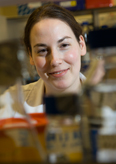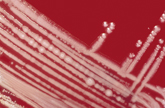
Dr Anne-Marie Krachler’s pioneering research focuses on flushing out pathogens rather than destroying them, as Ros Dodd reports.
Dr Anne-Marie Krachler made the biggest scientific breakthrough of her young career to date – a way to combat drug-resistant bacteria – while doing postdoctoral research in the United States. This coincided with injured American soldiers being flown home from war zones for treatment, only to develop sometimes-fatal bacterial infections.
‘This has been a real problem – troops returning home from the likes of Afghanistan and developing wound infections. Many of the bacteria that cause wound infections – such as Acinetobacter, Pseudomonas, Klebsiella and extended spectrum beta-lactamase-producing E.coli – are multi-drug-resistant. So soldiers were surviving their injuries but succumbing to wound infections,’ she says.
Scientists all over the world are working furiously to solve the growing problem of harmful bacteria – or pathogens – developing resistance to even the strongest antibiotics.
Austrian-born Anne-Marie’s approach is to tackle the bacteria before they get a grip – literally – on the body.
Although this isn’t an entirely novel approach, what makes it groundbreaking is that Anne-Marie has identified an entirely new family of proteins present in a wide variety of pathogens that are adept at adhering to host tissue, thereby enabling them to release their toxins into the body and cause a range of diseases.
This presents the exciting possibility of developing a broad-spectrum anti-adhesion therapy (AAT) inhibitor that is effective in ‘flushing out’ a plethora of harmful bacteria.
And this is the main focus of the Krachler Lab Anne-Marie has set up at the University’s Institute of Microbiology and Infection (IMI) since taking up a Birmingham Fellowship in March 2012.
‘Bacteria work by attaching to the host tissue; unless they attach, they can’t deliver the toxins,’ she explains. ‘What I found while I was in the States is a new group of adhesive – or sticky – proteins which is found in a wide variety of bacteria, particularly in some of the main disease-causing bacteria, rather than being in only one pathogen.’
Her discovery was serendipitous, as she had initially set out to identify new toxins in a bacterial genus called Vibrio.
Vibrio are gram-negative bacteria shaped like a curved rod, or a comma, several species of which can cause food-borne infection.
‘But instead of finding a new toxin, what I found was a new group of adhesive proteins, which are present in other food-borne pathogens such as Salmonella, and also in bacteria that cause wound infections, most of which are becoming or have become multi-drug-resistant.’
Once Anne-Marie had made this discovery, she realised that instead of having to target every single kind of pathogen, she could pursue a different strategy – that of developing an AAT that works against a variety of harmful bacteria.

To do that, Anne-Marie and her team are designing inhibitors – ways to stop the pathogens sticking to host tissue – which resemble the bacteria’s adhesive proteins and are as strong and as sticky as bad bacteria.
‘If you can block the binding sites on host tissue, the bacteria can’t attach themselves. Rather like in a car park, there are only a limited number of parking lots on the host tissue, so if they are already taken up by the inhibitors, there’s nowhere for the bad bacteria to bind themselves to, or “park”, so they get washed out in the body’s fluids.’
This AAT approach, then, focuses on fighting off the pathogens rather than killing them, which is actually more effective.
‘That’s because this is the first stage that has to happen to cause infection. If you get rid of the pathogens at the outset, the infection has nowhere to go and is washed out of the body – so that’s the end of the infection. It also has the added advantage that bacteria can’t develop resistance to adhesion inhibitors.’
Although still only 29, Anne-Marie has covered a great distance in her academic life – metaphorically as well as physically. She began her academic career as a chemical engineer, but switched to life sciences after completing her MSc at the University of Technology in Vienna and moving to the UK, where she worked on bacteria in Colin Kleanthous’s lab.
For four years until 2010, she undertook PhD research at the University of York as a Marie Curie Early Stage Fellow, focusing on structural biology, mainly on proteins that are involved in maintaining the cell envelope of gram-negative bacteria, aimed at discovering how to manipulate the bacteria’s machinery in order to disrupt the cell envelope.
‘Engineering is cool, but I didn’t want to build reactors,’ she says with a smile. ‘But, in a sense, bacteria are machines – only they’re living machines. I am fascinated by how we can manipulate machinery in living organisms – to find out how they work, dismantle them and put them back together differently so that they don’t cause harm.’
Her interest in chemistry began as a child, when she became enthralled by the process of making alcohol.
‘My family made their own liquor,’ she recalls. ‘We would go out into the garden to harvest plums and my father had set up distillation equipment in our basement. I used to sit there and watch how it was transformed from slushy stuff to nice clear stuff. I found it fascinating and wanted to do the same thing. So that’s why I became a chemist, although I became more and more interested in life sciences.
‘How life comes about and how even tiny things like bacteria can do amazing things, like create liquor or cause disease, increasingly began to fascinate me.’
After leaving Austria for York, Anne-Marie then crossed the Atlantic, to the UT Southwestern Medical Center in Dallas, where she joined Kim Orth’s lab and discovered the new family of proteins involved in host-pathogen interactions.
A year later she met Ian Henderson, professor of microbial biology at the IMI, at a bacterial adhesion conference, which paved the way for her return to Europe – and her arrival in Birmingham. Since then, Anne-Marie has been building up her laboratory and applying for research grants and EU funding.
She already has a patent out to obtain a licence to make an adhesion inhibitor that would block a wide range of gram-negative infections.
‘We still have a long way to go; we’ve been growing human tissues in a Petri dish to show that our inhibitors are blocking bad bacteria from infecting them, but still have to put it in an animal model. But it’s a very promising start.’
It’s particularly promising because when Anne-Marie carried out a group study at a military medical centre in Texas, isolating bacterial strains such as Klebsiella and E.coli from patients with serious wound infections, it showed that the AAT was ‘very efficient’ against these pathogens.
‘Although there is a long way yet to go to bring such a therapy to market, the research we’ve done so far gives us the hope that one day we’ll have something that’s more effective than ever the strongest antibiotics in combating harmful bacteria.'